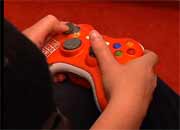
MONDAY, Nov. 28 (HealthDay News) — When young men who don’t normally play a lot of video games are exposed to violent video games, changes occur in the way their brains function, new research shows.
Using functional magnetic resonance imaging (fMRI), scientists were able to document altered brain responses after video game play. What’s more, some of those changes were still present a week later.
“We found that functioning has been changed in the brain by violent video games,” said Dr. Yang Wang, an assistant research professor in the department of radiology and imaging sciences at Indiana University School of Medicine in Indianapolis. “We found that activation [of an area of the brain that controls emotion] is decreased after playing violent video games.”
But, exactly what those changes mean, if anything, is still unknown.
“Clinically, we don’t know what these changes mean, but it does affect your brain somehow,” Wang said. “The pattern we found is similar to what we’ve seen in past research, and in adolescents is similar to what is seen in disruptive behavior disorders.”
Tracy Dennis, a child development expert and an associate professor of psychology at Hunter College in New York City, said: “This study is a good first step. It shows that if you do something over and over again for a period of time, it will affect your brain. But, what that means in the real world isn’t clear.”
Wang is scheduled to present the findings Wednesday at the Radiological Society of North America’s annual meeting this week in Chicago.
Whether or not violent video games cause harm to those who play them has been a subject of great debate for many years. Although experts on both sides of the issue continue to disagree, there’s little documented scientific evidence on what goes on in the brain during video game play.
In an attempt to provide some hard evidence, Wang and his colleagues recruited 22 healthy males between the ages of 18 and 29. These young men all reported low levels (less than one hour a week) of previous violent video game play.
The volunteers were randomly placed into one of two groups. One group was told to play a violent video game for about 10 hours at home in the first week, followed by a week of no violent video game play. The other group served as a control group and didn’t play video games for the two-week study period.
All of the volunteers underwent three fMRIs: one at the start of the study, another a week later, and the final one two weeks later. During the fMRIs, the volunteers were given an emotional interference test and a cognitive inhibition counting task.
The men who played violent video games showed less activation in the left inferior frontal lobe during the emotional task, and less activation in the anterior cingulated cortex during the counting task, compared to their own baseline test and to the control group after one week.
Wang said those areas of the brain are important for controlling emotions and aggressive behavior.
After the second week, when there was no video game play, the changes in the brain activation were reduced. Wang said the study wasn’t designed to assess whether or not if someone continually plays violent video games, the changes to the brain become permanent at some point.
“That may be a question for future research,” Wang noted.
“These changes don’t necessarily mean the brain region isn’t doing its job. There was decreased activity in the prefrontal cortex. Does that mean these men can’t use that area as well, or could it mean it’s become more efficient? You just don’t know. You just know that they had a change in their brain,” Dennis said.
If parents are concerned about their child’s video game play, Dennis recommends using common sense. “Limit the amount they’re playing. Don’t sit a kid in front of violent video games for hours at a time,” she advised.
Because this study was presented at a medical meeting, the data and conclusions should be viewed as preliminary until published in a peer-reviewed journal.
More information
Learn more about how violent video games might affect children from the American Academy of Child and Adolescent Psychiatry.

